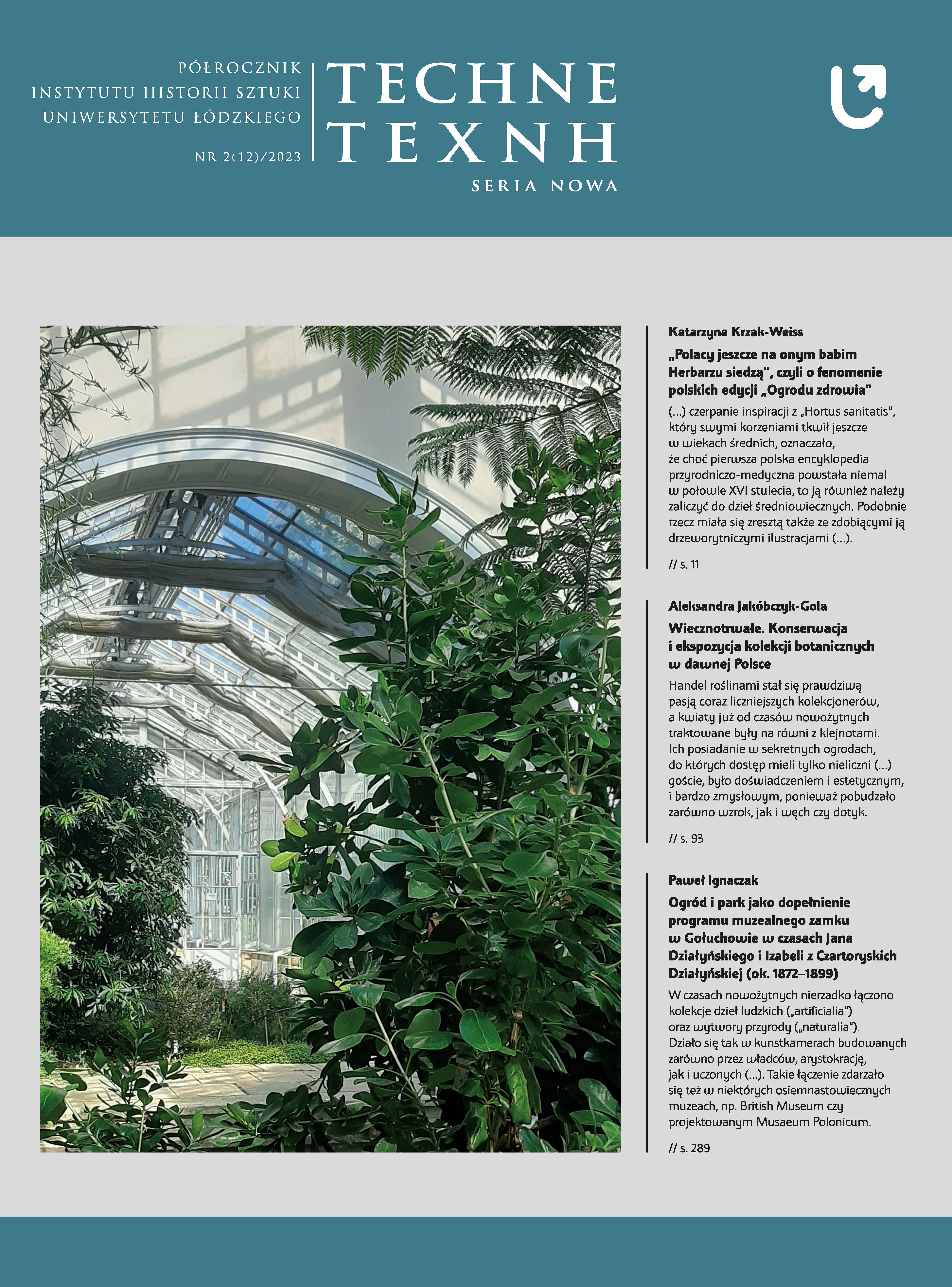Świadectwo krakowskiego ogrodu przełomu XV i XVI wieku
DOI:
https://doi.org/10.18778/2084-851X.16.03Słowa kluczowe:
zielnik, Kraków, inkunabuł, XV wiek, uprawa roślinAbstrakt
Jednym ze skutków rozwoju medycyny i botaniki w końcu XV wieku było pojawienie się różnego rodzaju ogrodów, w których hodowano rośliny lecznicze. Prócz prowadzonych niekiedy od stuleci ogrodów klasztornych nowe zakładali tak teoretycy, jak i praktycy ziołolecznictwa – lekarze, aptekarze i pierwsi botanicy. Wśród zawodów medycznych pojawili się profesjonalni ogrodnicy, którzy sprzedawali rośliny farmaceutom, a zapewne też udzielali podstawowych porad medycznych. W swojej pracy korzystali z naukowych (czy też quasi-naukowych) zielników gromadzących informacje o właściwościach i zastosowaniu roślin. W zbiorach Biblioteki Naukowej PAU i PAN w Krakowie znajduje się inkunabuł dokumentujący praktykę zawodową hodowcy roślin (Inc. 31). Niekompletny (brakuje w nim 120 z ponad 360 kart) egzemplarz Gart der Gesundheit z 1485 roku należał do niezidentyfikowanego, posługującego się językiem niemieckim krakowskiego ogrodnika, który w latach 1493–1527 poczynił w nim liczne notatki. Cały tekst został przez niego zindeksowany (na marginesach autor zanotował hasłowo najważniejsze elementy poszczególnych opisów roślin i opracował własny indeks). Bogato ilustrowany inkunabuł był dla niego nie tylko źródłem wiedzy (wynotowywał zastosowanie roślin, niekiedy proste receptury i różne spostrzeżenia medyczne oraz kulinarne, a także zamieszczał uwagi zasłyszane od krakowskich lekarzy), ale też notatnikiem handlarza (przy większości roślin zapisane są ceny skupu, które płacono w aptekach aglomeracji krakowskiej, a przy kilku także ceny sprzedaży i źródło, skąd pozyskiwał nasiona bądź rzadką roślinę) oraz hodowcy (większość notatek dotyczy czasu kiełkowania i kwitnięcia roślin oraz ich wyglądu, zwłaszcza elementów nieukazanych na drzeworytach lub niedokładnie przedstawionych).
Ilustracje były dla niego równie istotne jak tekst zielnika. Nowe, opracowane w Moguncji w końcu XV wieku drzeworyty były względnie realistyczne i pozwalały szybko znaleźć odpowiednie hasło i zidentyfikować roślinę. Krakowski właściciel dodatkowo dopisywał przy przedstawieniach roślin ich niemieckie, łacińskie i polskie nazwy (czasem odmienne niż w niemieckim druku). Co więcej, swój egzemplarz najprawdopodobniej kupił już pokolorowany, bo wśród notatek są także jego uwagi na temat jakości ilustracji i ewentualnych różnic między rzeczywistą rośliną i jej przedstawieniem, obejmujące przede wszystkim barwę liści i kwiatów.
Mimo że krakowski egzemplarz Gart der Gesundheit został zniszczony w czasie XIX-wiecznej konserwacji (obecnie brak w nim ⅓ kart oraz oryginalnej oprawy), przez co nie można zidentyfikować jego pierwszego właściciela, zamieszczone w nim notatki pozwalają nam zobaczyć, jak na przełomie XV i XVI wieku wykorzystywano bogato ilustrowane publikacje naukowe z zakresu botaniki i ziołolecznictwa. Chociaż książka nie była tania, miała dla niego przede wszystkim znaczenie użytkowe i była traktowana jako swoisty almanach, który daje wgląd w środowisku hodowców roślin tego okresu, ale też w przyrodę i klimat Krakowa przełomu średniowiecza i nowożytności.
Bibliografia
AN PAN PAU, TNK-28 – Archiwum Nauki PAN i PAU, TNK-28, Dziennik podawczy korespondencji z lat 1840–1860.
Google Scholar
BAUMANN/BAUMANN 2010 – Helmut Baumann, Brigitte Baumann, Die Mainzer Kräuterbuch-Inkunabeln: „Herbarius Moguntinus” (1484), „Gart der Gesundheit” (1485), „Hortus Sanitatis” (1491). Wissenschaftshistorische Untersuchung der drei Prototypen botanisch-medizinischer Literatur des Spätmittelalters, Stuttgart 2010.
Google Scholar
DĄBROWA/KNAPEK/WOJTOWICZ 2015 – Teresa Dąbrowa, Elżbieta Knapek, Jacek Wojtowicz, Katalog inkunabułów Biblioteki Naukowej PAU i PAN w Krakowie, Kraków 2015.
Google Scholar
GWD – Gesamtkatalog der Wiegendrucke, Berlin 2009–2023, http://www.gesamtkatalogderwiegendrucke.de/ [dostęp: 25.04.2023].
Google Scholar
GIEDROYĆ 1905 – Franciszek Giedroyć, Materiały do dziejów farmacji w dawnej Polsce. Spis aptekarzy (w. XIV–XVIII), Warszawa 1905.
Google Scholar
KAWECKA-GRYCZOWA 1970 – Incunabula quae in bibliothecis Poloniae asservantur, red. Alodia Kawecka-Gryczowa, Warszawa i in. 1970.
Google Scholar
MACIUK/MRÓWKA 2015 – Marcin Maciuk, Marcin, Małgorzata Mrówka, Wznosząc gmach narodowej wiedzy: 200. rocznica powołania Towarzystwa Naukowego Krakowskiego, Kraków 2015.
Google Scholar
DOI: https://doi.org/10.4467/12332135KRA.16.019.15065
MAJER 1879 – Józef Majer, Notatki fitofenologiczne robione w Krakowie od r. 1490–1527, „Sprawozdanie Komisyi Fizyograficznej… w ciągu roku 1878”, t. 13, Kraków 1879, s. 266–268.
Google Scholar
OGILVIE 2006 – Brian W. Ogilvie, The Science of Describing. Natural History in Renaissance Europe, Chicago 2006.
Google Scholar
DOI: https://doi.org/10.7208/chicago/9780226620862.001.0001
REEDS 1991 – Karen Meier Reeds, Botany in Medieval and Renaissance Universities, New York–London 1991.
Google Scholar
ROESKE 1991 – Wojciech Roeske, Polskie apteki, Wrocław 1991.
Google Scholar
ROSTAFIŃSKI 1900 – Józef Rostafiński, Symbola ad historiam naturalem medii aevi, t. 1–2, Kraków 1990.
Google Scholar
SEREDYŃSKI 1869 – Władysław Seredyński, Rękopismy Towarzystwa Naukowego systematycznie zestawione, Kraków 1869.
Google Scholar
SWAN 2006 – Claudia Swan, The Uses of Realism in Early Modern Illustrated Botany, [w:] Visualizing Medieval Medicine and Natural History 1200–1550, red. Jean A. Givens, Karen Meier Reeds, Alain Touwaide, Aldershot 2006, s. 239–250.
Google Scholar
SZAFER 1922 – Władysław Szafer, O fenologicznych porach roku w Polsce, „Kosmos” 1922, t. 47, s. 371–411.
Google Scholar
ŚWIEŻAWSKI/WENDA 1887 – Ernest Świeżawski, Kazimierz Wenda, Materiały do dziejów farmacji w dawnej Polsce, t. 3, Warszawa 1887.
Google Scholar
WIERZBICKA 1964–1965 – Eugenia Wierzbicka, Botanika w Polsce średniowiecznej, „Wiadomości Botaniczne” 1964–1965, t. 8–9, s. 79–91, 133–47.
Google Scholar
WŁODARCZYK 2011 – Zofia Włodarczyk, Rośliny biblijne. Leksykon, Kraków 2011.
Google Scholar
DOI: https://doi.org/10.1186/1687-1812-2011-90
Pobrania
Opublikowane
Jak cytować
Numer
Dział
Licencja

Utwór dostępny jest na licencji Creative Commons Uznanie autorstwa – Użycie niekomercyjne – Bez utworów zależnych 4.0 Międzynarodowe.








